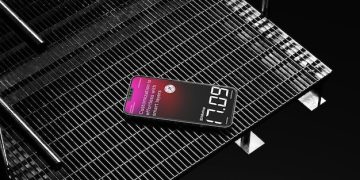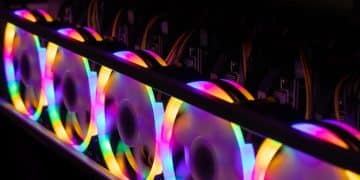External Hard Drives for Gaming: Boost Storage & Maintain Speed
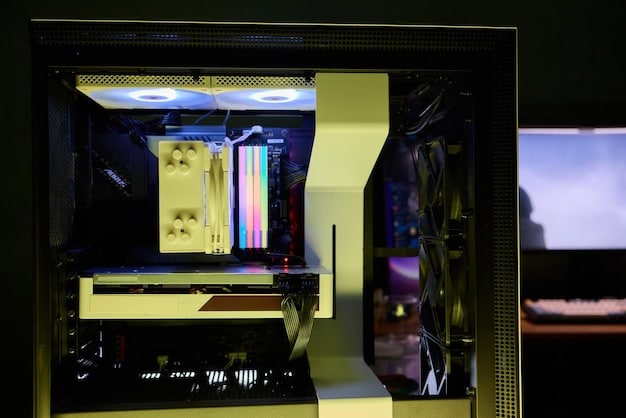
External hard drives offer a pragmatic solution for gamers needing more storage without compromising gaming performance, integrating seamlessly to expand digital libraries.
In the evolving landscape of digital gaming, the sheer size of modern video games often poses a challenge for internal storage. An effective solution comes in the form of external hard drives for gaming: increase storage capacity without sacrificing speed, allowing players to expand their digital libraries effortlessly.
Understanding the Need for External Storage in Gaming
Modern video games are notorious for their large file sizes, with some titles exceeding 100 GB. This rapidly consumes internal storage on gaming PCs and consoles, leading to frequent deletions and re-downloads. External storage offers a simple yet powerful remedy, providing ample space for an ever-growing game collection without the hassle of constantly managing internal drive space.
The demand for larger storage solutions is driven by several factors, including increasingly detailed graphics, high-resolution textures, complex game worlds, and continuous content updates. For avid gamers, this translates into a constant battle against storage limitations, making external drives an almost essential component of their gaming setup.
The Ever-Growing Digital Game Library
As digital game purchases become the norm, physical media becomes less common. Each downloaded game consumes precious storage, pushing the boundaries of even high-capacity internal drives. An external drive acts as a dedicated repository, allowing gamers to keep a vast library readily accessible.
- Convenience: Store more games without constant installation/uninstallation.
- Accessibility: Carry games between different gaming setups or consoles.
- Organization: Keep internal drives decluttered for optimal system performance.
Beyond convenience, external storage enhances the gaming experience by eliminating the frustration of limited space. This is particularly true for players who enjoy a wide variety of genres, from massive open-world titles to smaller indie gems, all of which contribute to storage strain.
Types of External Drives: SSD vs. HDD for Gaming
When considering an external drive for gaming, the primary choice lies between two technologies: Solid State Drives (SSDs) and Hard Disk Drives (HDDs). Both have distinct characteristics that impact performance, cost, and durability, making the choice dependent on individual priorities.
Solid State Drives (SSDs) and Their Advantages
SSDs are distinguished by their use of flash memory for data storage, resulting in significantly faster read and write speeds compared to HDDs. This translates directly into quicker game loading times, faster texture streaming, and overall smoother gameplay. For competitive gamers or those who simply value speed, an external SSD is often the preferred choice.
While typically more expensive per gigabyte than HDDs, the performance benefits of SSDs are undeniable. They are also more durable, as they have no moving parts, making them less susceptible to damage from drops or bumps. This portability and robustness are significant advantages for gamers who frequently transport their drives.
- Superior Speed: Dramatically reduced loading times for games and levels.
- Enhanced Durability: More resistant to physical shock due to no moving parts.
- Quiet Operation: Silent during use, unlike the mechanical whirring of HDDs.
Current generation consoles, such as the PlayStation 5 and Xbox Series X, already rely heavily on internal SSDs to deliver their next-gen experiences. Utilizing an external SSD can help maintain similar performance levels for games stored externally, bridging the gap between internal and external storage speeds.
Hard Disk Drives (HDDs) and Their Role
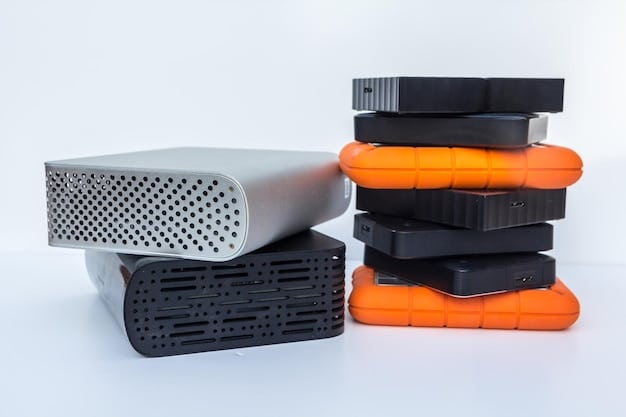
HDDs store data on spinning platters accessed by read/write heads. While slower than SSDs, HDDs offer a significantly lower cost per gigabyte, making them an excellent choice for budget-conscious gamers who need vast amounts of storage. For storing a large back catalog of games or less frequently played titles, an external HDD can be a highly economical solution.
The primary trade-off with HDDs is speed; load times will be longer than with an SSD. However, once a game is loaded, the difference in gameplay performance is often minimal, as the internal components of the PC or console take over processing. For games that are not heavily reliant on continuous data streaming, an HDD remains a viable and cost-effective option.
When choosing an HDD, factors like rotational speed (RPM – revolutions per minute) and cache size can influence performance. Higher RPM (e.g., 7200 RPM) and larger cache sizes generally provide better speeds. However, even the fastest HDDs cannot match the raw speed of an SSD.
Connectivity and Compatibility: USB, Thunderbolt, and Console Specifics
The performance of an external drive is not solely determined by its internal technology (SSD or HDD) but also by its connection interface. Understanding the various connectivity options is crucial for maximizing an external drive’s potential, ensuring data transfer speeds do not bottleneck the drive’s capabilities.
Understanding USB Generations: USB 3.0, 3.1, 3.2, and USB-C
The most common interface for external drives is USB, which has evolved through several generations, each offering increased bandwidth. USB 3.0 (also known as USB 3.1 Gen 1 or USB 3.2 Gen 1×1) provides speeds of up to 5 Gbps, a significant improvement over USB 2.0. USB 3.1 Gen 2 (or USB 3.2 Gen 2×1) doubles this to 10 Gbps, and USB 3.2 Gen 2×2 offers 20 Gbps.
USB-C refers to the physical connector shape, not necessarily the speed. However, most modern USB-C ports support faster USB protocols (like USB 3.1 Gen 2 or higher) and can even support Thunderbolt. Always check the specific USB standard supported by the port on your device and the external drive to ensure optimal performance.
- USB 3.0/3.1 Gen 1: Commonly found, offers good performance for most HDDs and entry-level SSDs.
- USB 3.1 Gen 2: Ideal for external SSDs, delivering noticeable speed benefits.
- USB 3.2 Gen 2×2: The fastest non-Thunderbolt USB option, perfect for high-performance external SSDs.
Choosing a drive and port that match in terms of USB generation ensures that the connection itself doesn’t limit the drive’s data transfer capabilities. An old USB 2.0 port, for example, will severely bottleneck even the fastest external SSD.
Thunderbolt Connectivity for Peak Performance
Thunderbolt, developed by Intel, offers even higher data transfer rates than standard USB. Thunderbolt 3 and 4 provide up to 40 Gbps, making them the fastest external connectivity options available for consumers. This immense bandwidth is particularly beneficial for professionals working with large files, but it also translates into negligible performance loss for external SSDs used in gaming.
While currently more prevalent on high-end PCs and Apple devices, Thunderbolt external drives provide the ultimate in speed and responsiveness. If your gaming rig has a Thunderbolt port, investing in a compatible external drive can offer performance very close to an internal drive.
Console-Specific Considerations: PS5 and Xbox Series X/S
Gaming consoles have specific requirements and limitations for external storage. Both the PlayStation 5 and Xbox Series X/S support external USB drives, primarily for storing older generation games (PS4 games on PS5, Xbox One/360/Original Xbox games on Series X/S).
For current-generation PS5 and Series X/S games, specific solutions are needed due to their reliance on ultra-fast internal SSDs. The PS5 uses a certified internal NVMe SSD slot for expansion, while the Xbox Series X/S uses proprietary expansion cards that match the speed of their internal drives. While you can store new-gen games on external USB drives, you cannot play them directly from there; they must be transferred back to the internal drive or proprietary expansion card to be played.
Factors to Consider Beyond Speed and Storage
While speed and capacity are paramount, several other factors contribute to the overall usability and effectiveness of an external hard drive for gaming. These include portability, cooling, power requirements, and additional features that can improve the user experience.
Portability and Form Factor
External drives come in various sizes and weights. Smaller, lighter drives (often SSDs) are ideal for gamers who frequently travel or move their setup. Larger, desktop-style HDDs might require external power and are generally less portable but often offer higher capacities at a lower price point. Consider how often you’ll need to transport your drive when making a decision.
Most portable external drives are bus-powered, meaning they draw power directly from the USB port, eliminating the need for an external power adapter. Desktop drives, especially those with multiple platters or higher capacities, often require their own power supply.
Cooling and Durability
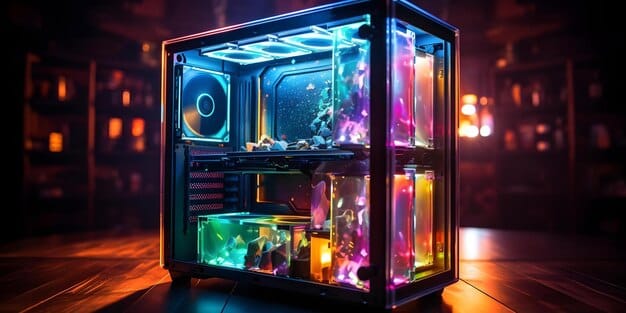
Heat can be a factor, especially for high-performance drives or during extended gaming sessions. Some external drive enclosures are designed with passive cooling features like aluminum casings to dissipate heat. While usually not a major concern for external drives used intermittently, continuous heavy use could benefit from better thermal management.
Durability, particularly for portable drives, is also important. SSDs inherently offer better shock resistance due to their lack of moving parts. Some external enclosures also feature rugged designs with extra protection against drops and impacts.
Power Requirements and Reliability
As mentioned, bus-powered drives are convenient. However, ensure your device’s USB port can supply sufficient power, especially for larger HDDs. Reliability is crucial; choosing reputable brands known for their quality control and customer support can save headaches down the line. Look for drives with good warranty periods and positive user reviews.
It is always advisable to back up critical game save files, regardless of the drive type. While external drives are generally reliable, no storage device is immune to failure. Consider cloud saves or a secondary backup for irreplaceable data.
Optimizing Your External Drive for Gaming Performance
Simply plugging in an external drive isn’t always enough to get the best performance. There are several steps gamers can take to optimize their external storage setup, ensuring games run as smoothly as possible and data transfers are efficient.
Formatting and File Systems
The file system of your external drive can impact its compatibility and performance. For Windows PCs, NTFS is the standard. For Macs, HFS+ or APFS are typical. If you plan to use the drive across different operating systems or with game consoles, exFAT is often recommended as it offers broad compatibility, though it may not be as robust as system-specific file systems.
Consoles usually require drives to be formatted in a specific way upon connection. For instance, PlayStation consoles might reformat the drive to their proprietary file system, rendering it unusable on a PC without re-formatting. Always check the console’s requirements before connecting an external drive with existing data.
Proper Game Installation and Management
When installing games, most launchers (Steam, Epic Games, etc.) allow you to choose the installation directory. Directing installations to your external drive, especially an SSD, ensures games are playable directly from there. For consoles, management can be more automatic once the drive is set up as extended storage.
- Dedicated Game Folder: Create a specific folder on the external drive for all your games.
- Avoid Fragmentation: While less critical for SSDs, try to install games contiguously on HDDs.
- Monitor Performance: Use disk monitoring tools to check drive health and transfer speeds.
Regularly reviewing your game library can also help. Uninstall games you no longer play to free up space, especially on smaller, faster drives, or move them to a larger, slower external HDD for archival purposes.
Future-Proofing Your Gaming Storage Setup
As games continue to grow in size and graphical fidelity, storage demands will only increase. Planning ahead can save you from needing to constantly upgrade or reconfigure your setup. Consider emerging technologies and strategies for long-term storage sustainability.
Scalability and Expandability
When choosing an external drive, consider its potential for future expansion. While some enclosures allow for multiple drives, most consumer external drives are single-unit solutions. If you anticipate needing significantly more storage in the future, purchasing a higher-capacity drive now, or one from a series that offers higher capacities, can be a wise move.
Alternatively, consider network-attached storage (NAS) devices if you have a home network. A NAS can serve as a centralized storage solution for games and other media across multiple devices, though it introduces network latency that might impact direct gameplay from the NAS.
Technological Advancements in Storage
The storage landscape is constantly evolving. NVMe (Non-Volatile Memory Express) technology, which significantly boosts SSD performance by reducing latency, is becoming standard for internal drives and is increasingly found in external enclosures via Thunderbolt or high-speed USB interfaces. Keeping an eye on these advancements can inform future purchasing decisions.
Emerging technologies like CXL (Compute Express Link) and new flash memory types promise even faster and more efficient storage. While not immediately relevant for consumer external drives, these advancements will eventually trickle down, offering even better performance per dollar for future gaming setups. The key is to balance current needs with an understanding of where technology is headed.
| Key Point | Brief Description |
|---|---|
| 🎮 Enhanced Storage | External drives effectively expand game libraries, reducing the need for constant deleting and re-downloading. |
| ⚡ Speed vs. Cost | SSDs offer superior speed and durability for performance-critical games, while HDDs provide high capacity at a lower cost for general storage. |
| 🔌 Connectivity Matters | USB 3.0+ and Thunderbolt interfaces ensure optimal data transfer speeds, crucial for minimizing performance bottlenecks. |
| ⚙️ Optimization Tips | Proper formatting, game management, and considering future tech contribute to a seamless gaming experience. |
Frequently Asked Questions About External Hard Drives for Gaming
▼
An external HDD might result in slightly longer loading times compared to an internal SSD. However, once the game loads, the speed difference during gameplay is usually negligible as the game data is already in RAM. An external SSD generally performs very comparably to an internal SSD for most gaming scenarios.
▼
For optimal speed, Thunderbolt 3 or 4 is best, followed closely by USB 3.2 Gen 2×2. These interfaces offer maximum bandwidth, ensuring that a fast external SSD can perform at its peak. For HDDs, USB 3.0 (or its equivalents) is usually sufficient, as the drive’s internal speed will be the limiting factor.
▼
For PlayStation 5 and Xbox Series X/S, current-gen games typically cannot be played directly from standard external USB drives due to speed requirements; they need to be on the internal SSD or specific expansion cards. Older generation games (PS4, Xbox One/360) can usually be played directly from external USB drives.
▼
An external SSD is generally better due to its superior speed, leading to faster load times and smoother in-game performance, especially for modern, demanding games. However, an external HDD is a more cost-effective option for storing a large volume of games where loading speed is not a critical concern.
▼
An external drive primarily affects game loading times and asset streaming. It does not directly impact CPU, GPU, or RAM performance. By offloading game installations from your internal drive, it can actually free up space on your primary drive, potentially improving overall system responsiveness and preventing fragmentation.
Conclusion: Expanding Horizons for Gaming
The journey through the world of external hard drives for gaming reveals a clear path to overcoming storage limitations without compromising the gaming experience. Whether opting for the blistering speed of an SSD or the vast capacity of an HDD, the right external drive provides gamers with the freedom to build and maintain extensive game libraries. This strategic expansion of storage ensures that players can continue to explore new worlds, conquer challenges, and immerse themselves fully in the digital realm, all while maintaining the speed and responsiveness their gaming demands.
